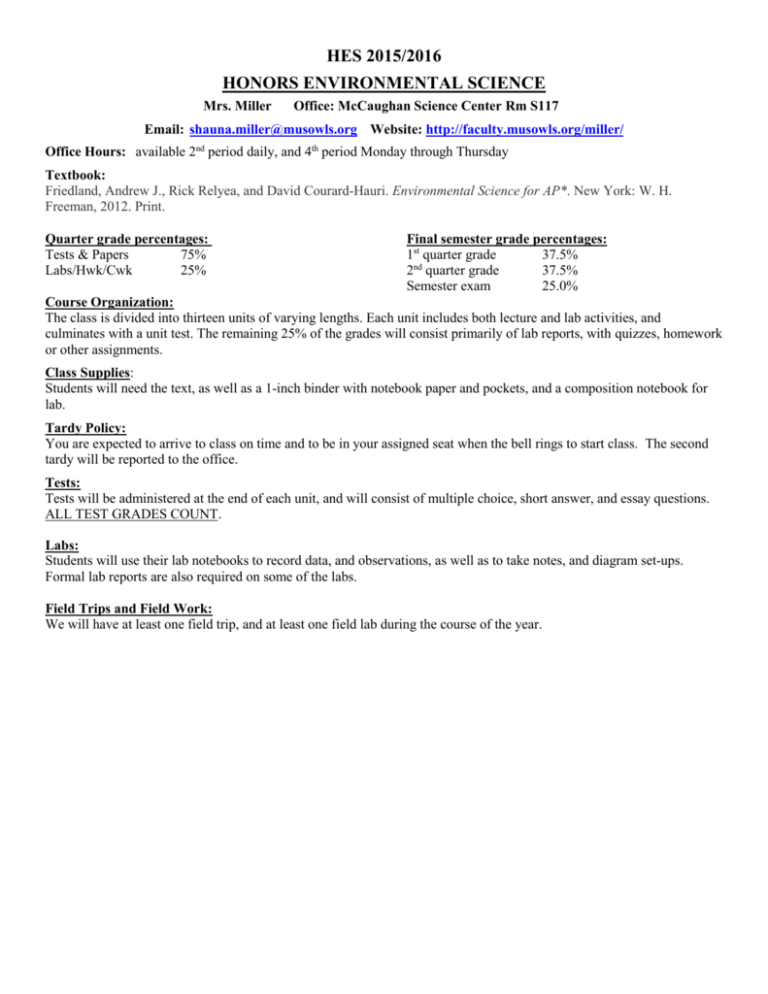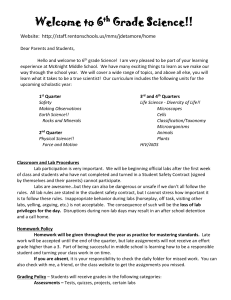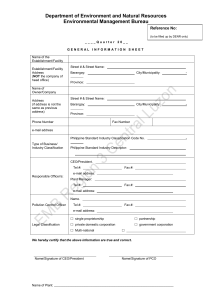HES Syllabus 2015
advertisement

HES 2015/2016 HONORS ENVIRONMENTAL SCIENCE Mrs. Miller Office: McCaughan Science Center Rm S117 Email: shauna.miller@musowls.org Website: http://faculty.musowls.org/miller/ Office Hours: available 2nd period daily, and 4th period Monday through Thursday Textbook: Friedland, Andrew J., Rick Relyea, and David Courard-Hauri. Environmental Science for AP*. New York: W. H. Freeman, 2012. Print. Quarter grade percentages: Tests & Papers 75% Labs/Hwk/Cwk 25% Final semester grade percentages: 1st quarter grade 37.5% 2nd quarter grade 37.5% Semester exam 25.0% Course Organization: The class is divided into thirteen units of varying lengths. Each unit includes both lecture and lab activities, and culminates with a unit test. The remaining 25% of the grades will consist primarily of lab reports, with quizzes, homework or other assignments. Class Supplies: Students will need the text, as well as a 1-inch binder with notebook paper and pockets, and a composition notebook for lab. Tardy Policy: You are expected to arrive to class on time and to be in your assigned seat when the bell rings to start class. The second tardy will be reported to the office. Tests: Tests will be administered at the end of each unit, and will consist of multiple choice, short answer, and essay questions. ALL TEST GRADES COUNT. Labs: Students will use their lab notebooks to record data, and observations, as well as to take notes, and diagram set-ups. Formal lab reports are also required on some of the labs. Field Trips and Field Work: We will have at least one field trip, and at least one field lab during the course of the year. Topic(s) 2nd Quarter 1st Quarter Qtr Unit Chapter(s) 1 1&2 Studying the State of Our Earth Environmental Systems 2 3&4 Ecosystem Ecology Global Climates & Biomes 3rd Quarter The Lorax (original) The Tragedy of the Commons Halflife Property of a Radioactive Element Owl Pellet Analysis Hurricane Strike! Evolution of Biodiversity Predator-Prey Relationships EcoKit Carrying Capacity Lab Natural Selection: Peppered Moth 6&7 Population & Community Ecology The Human Population How Will Our Population Grow? Age Structure Diagrams 5 8&9 Earth Systems Water Resources The Hash Rock Fire 6 10 Land, Public, & Private Habitat: The Choice is Yours Endangered Species Research Paper Feeding the World Energy Resources & Consumption Food Inc Soil Analysis Lab Cookie Mining Mine Pollution & Reclamation Achieving Energy Sustainability Switch Electricity Use and Efficiency Energy Practice Problems 20/20 Fracking Video 3 5 4 7 4th Quarter Labs/Activities/Videos/Research Papers 11 & 12 8 13 9 14 & 15 Water Pollution Air Pollution & Stratospheric Ozone Depletion Bacterial Examination of Drinking Water Exploring Deposition of Sediments Groundwater Pollution lab 10 16 & 17 Waste Generation & Waste Disposal Human Health & Environmental Risk How Much is too Much? (LD50 or LC50) Water Pollutants in the Living Organism 11 18 & 19 Conservation of Biodiversity Global Change How Hot is it here on Earth? Soylent Green 12 20 Sustainability, Economics, & Equity Community Planning: Not in My Backyard









